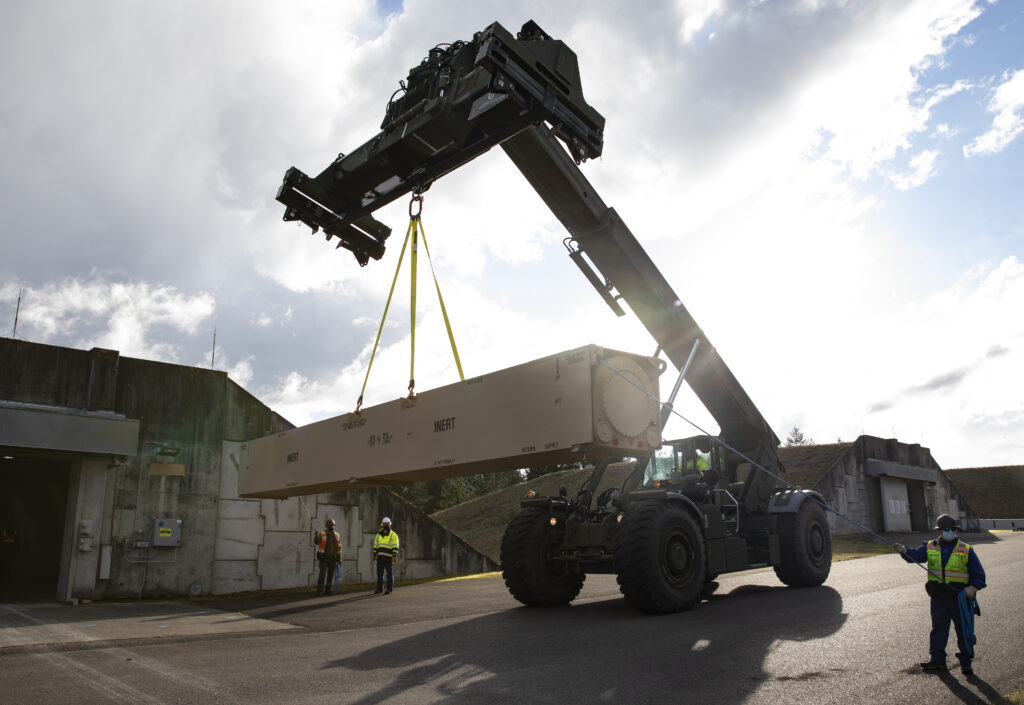
WASHINGTON: Lockheed Martin’s new Precision Strike Missile hasn’t yet been test-fired at its maximum range, a classified figure the Army will only say is more than 500 kilometers (311 miles). But the service is already studying potential upgrades that could give PrSM what the Army calls “mid-range capability,” something they’ve previously defined as over 1,600 km (1,000 miles) – roughly three times as far.
Currently, the Army is buying the venerable Tomahawk and the supersonic SM-6 as stopgap Mid-Range Capability weapons, but it’s looking at other options for the long term, including DARPA-developed hypersonics and the upgraded PrSM.

The Army’s aspiration is to make PrSM able to fire at “mid-range,” said Brig. Gen. John Rafferty, Army Futures Command’s director of Long-Range Precision Fires, in an exclusive interview. While Rafferty didn’t define that term, the general developing Mid-Range Capability defined mid-range in an earlier interview as “around 1,800 kilometers” — about 1,100 miles.
“We’re also in the early stages of the extended range options for PRSM, and there’s a couple of a couple [advanced propulsion] options that we’re looking at that really get the range of PRSM out to that mid-range,” Rafferty told me. “Then, if we have the Mid-Range Capability out of our existing launchers… then that’s really the future for this mid-range space.”
“That’s what we’re exploring now,” he emphasized. “It’ll take us a while to get there.”

Meanwhile, the Army has issued training mock-ups of hypersonic missiles to its initial Long Range Hypersonic Weapon (LRHW) battery. The first live weapons will arrive by September 2023 and will fire well over a thousand miles. By September of this year, the battery will have its truck-mounted launchers, command posts, and “everything except their live rounds” so it can begin a two-year train-up, said Bob Strider of the Army’s Rapid Capabilities & Critical Technologies Office in an interview with Breaking Defense. (The Navy and the Army use the same hypersonic missile but with different packing for truck-borne vs. ship-mounted launchers).
Then, for the tactical end – targets less than 100 miles away – the service is building prototypes of the Extended Range Cannon Artillery (ERCA) armored howitzer, with a battalion of 18 prototype vehicles expected, again, in 2023. “Prototype Zero,” which won’t be part of the battalion, has already fired live rounds in last year’s Project Convergence wargames and recently completed extensive “characterization” tests. The upgraded Prototypes 1-4 will be delivered later this year, and 5-8 early next. These guns will fire precision-guided and rocket-boosted projectiles over ranges up to almost 100 miles, but those sophisticated shells will be loaded by hand until an autoloader upgrade is available ca. 2025.

PrSM enters service in 2023. Last year, it did a successful series of three short-range flight tests: PrSM’s rocket motor is so powerful it’s actually more stressful on the missile to rein it in for shots under 100 miles than to let it rip for 300-plus.
But the attraction of PrSM has always been its range, which while shorter than hypersonics is still much longer than the longest-range weapon in the Army’s inventory today, the Reagan-era ATACMS, which can fly 300 km (186 miles). How far can PrSM shoot? The original program was constrained by the INF Treaty, which banned the US and Russia (but not China) from developing land-based missiles with ranges between 500 and 5,500 km. But that was never a fundamental technical limit of the Lockheed Martin design, and as soon as President Trump pulled out of the treaty, the Army began describing PrSM’s range as “500-plus km” (over 311 miles).
PrSM will do four long-range test shots this year, said Brig. Gen. John Rafferty, head of the Long-Range Precision Fires team at Army Futures Command. That’ll include a 400-km shot at White Sands Missile Range in New Mexico in May and maximum-range, a 500-plus-km shot at Vandenberg Air Force Base in California in August, since Army test ranges aren’t big enough. In the fall, there’ll be a double shot –two PrSM missiles from the same HIMARS launcher truck – as part of the Project Convergence 2021 wargames.
But the Army is already working on upgrades to the baseline PrSM missile. That includes a seeker to track moving targets on land or sea, homing in on their radio-frequency emissions, which will be added to the missile around 2026-2027. (The Army had hoped to make it by 2025 but couldn’t find the funding). The seeker has had two successful “captive carry” tests on aircraft and will be test-fired on a surrogate missile in July at White Sands.
Upgrades also include the new advanced propulsion systems that – without making PrSM too big to fit in HIMARS launchers – will dramatically increase the range.

